important to understand the thinking behind both the 'principles' and
'programme' approaches. Dr Lala Manners explains.

The 'principles' approach to early years Physical Development (PD) has a long and illustrious history. Central to mid-20th century pedagogical thinking, PD was never considered as separate from other areas of development. It underpinned and informed all learning and was only obliquely linked to general health and mental well-being. It is only relatively recently that PD programmes have emerged in response to assessment demands of the curriculum and health/obesity initiatives - both of which require a significant level of quantitative data to support effective implementation.
The 'principles' and 'programme' approaches to PD are not mutually exclusive and in practice are used equally by professionals as they adapt and react to changing needs and situations. More so than any other area of the curriculum, PD must accommodate a wide range of variables. In the subtle shift from PD playing a fundamental role in children's learning to becoming a prime area of the Early Years Foundation Stage (with 'goals') and - in the absence of a cohesive strategy for the design and delivery of practical sessions - it is imperative that professionals are aware of the thinking behind both approaches, to make informed decisions that may develop and support best practice.
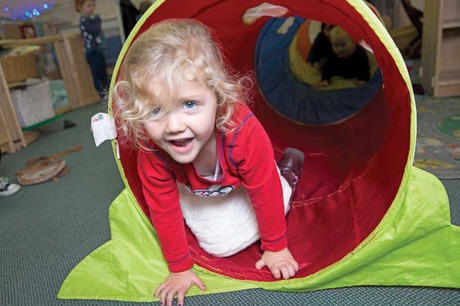
THE PROGRAMME APPROACH
Historically, PD programmes were designed for sport, gymnastics and dance. However, there is currently a range of early years PD programmes available that make obvious links to the curriculum and the issue of 'school-readiness'. Whatever the specific focus, PD programmes will share these common characteristics:
- The acquisition, rehearsal and refinement of physical skills/competencies is central to the design and delivery of practical sessions.
- Skills are acquired sequentially and enhanced through repetition over time.
- Often there will be a syllabus to follow with accompanying assessment procedures.
- Apparatus will be skill specific and linked to team work or competition.
- Resources will include manuals, laminated cards and rewards (such as stickers, cups or medals).
Advantages and disadvantages
There are many advantages to using this approach. Programmes are generally simple to deliver, monitor and assess; they use time efficiently and immediate results are evident; uniformity of movement is assured and children become adept at replicating movements; they also become very competent at processing instructions. A 'direct' teaching style is often used that suits many professionals.
The programme approach does have disadvantages: creativity and self-expression are not generally encouraged and it is difficult to accommodate individual differences in development and ability; the focus on physical performance and end-product does not account for the other areas of development profoundly affected by children's physical experience.
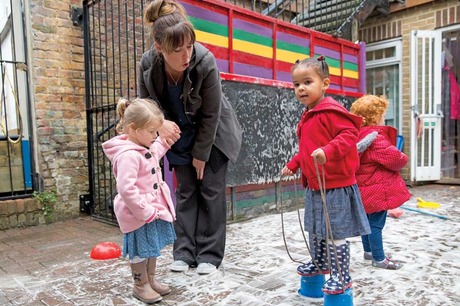
THE PRINCIPLES APPROACH
Historically, this approach lay at the heart of early years pedagogy. PD was recognised as affecting and informing all areas of development and certain generic principles emerged. All approaches to PD that highlight the learning experience for children, and not the acquisition and performance of specific physical skills, will have most - if not all - of these principles at their core. The principles answered the question: 'Why is PD important and how may this be reflected in practice?'
Provision for PD was unspecific and not primarily related to skill acquisition. It was seamlessly embedded in daily practice as children were afforded a range of physical experiences that encouraged self-direction and discovery. Positive behaviours and dispositions that emerged from physical activity were considered as important as the physical competencies necessary to manage life in general.
Advantages and disadvantages
Advantages of the principle approach:
- Physical experience is considered to affect learning across all developmental domains.
- It is not primarily performance or goal focused. The fact that change may emerge in unexpected ways and that skills may not be acquired sequentially is, therefore, not problematic.
- Allowance is afforded to individual differences and so inclusion is encouraged and supported.
- A wide variety of resources may be used and these are not obviously related to physical skills.
- Physical activity becomes a natural element of the day, rather than something that must be continually organised, monitored and assessed.
The main disadvantage to this approach is that an 'indirect' teaching style requires more time, patience and confidence from the practitioner. However, with an understanding of the eight guiding principles (explanations to follow), best practice may be supported in this area and a deeper understanding emerge of the relevance of PD to daily provision.
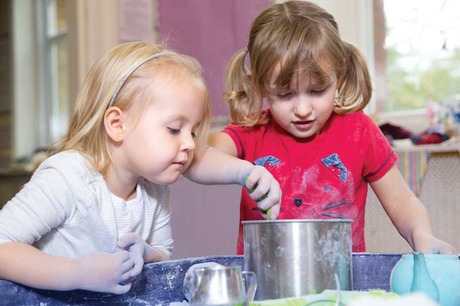
THE EIGHT GUIDING PRINCIPLES
1. Movement is the primary means by which concepts are experienced
Physical development in a child's life is not just about skill acquisition. Provision for PD in settings (education, care, sport, therapy) will use physical activity and movement as a learning aid to:
- introduce concepts - forces, weight, speed, time and number
- highlight behaviours - delegation, co-operation, praise, perseverance, resilience, or
- focus on particular skills that have been observed as needing attention.
An example: jumping
- How do we jump? Explore different types of jumps.
- Why do we jump? For safety, fun, dance, flight, sport?
- Do all animals jump?
- Make links to music and games.
- Find 2D representations of jumps and jumping and extend this exploration to poems, literature and group storytime.
Relevance
- Adults become more aware of the wider implications and learning potential of PD.
- Closer observation of children engaging in physical activity encourages awareness of the effect growing confidence and competence has on their play, language, communication and social skills.
- Starting with the physical experience of wider learning objectives allows children to make personal references that may be drawn on later in other situations - particularly engagement with art and literature.
2. Start where the children are
In physical terms, this means building on the skills that children have acquired through natural growth and development, and those that they are comfortable and willing to practise. Many children will attend dance classes or sports clubs, but these are children who may well need to return to the basics of natural whole-body movement to support their activities.
Relevance
- Such an approach supports children's natural enjoyment of movement and may well support extra-curricular activities.
- It encourages accurate observation and assessment of children's progress and potentially provides a more holistic and sympathetic view of their physical development. Assessment is not just about competencies and performance.
- Practical sessions may be designed to accurately reflect levels of development, so activities are always within the capabilities of the group and support inclusion.
- Planning may be fluid and adapted to accommodate the variables of venue, support, numbers and children's interests.
3. Immediate environment is used as a learning aid
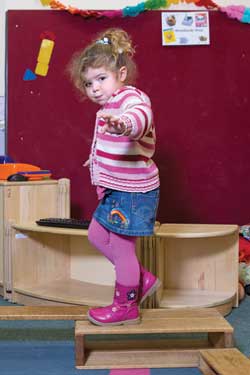 In movement terms, the 'immediate environment' has three elements:
In movement terms, the 'immediate environment' has three elements:
- Self The first point of reference for young children will be their physical selves: how is the body made up (different parts and their properties, such as muscles, bones and cartilage)? What can their bodies do (the difference between voluntary and involuntary movement, such as yawning or stretching)? What do their bodies like to do and find difficult? What they are wearing? What do they look like?
- Group How does an individual relate to the group? Who is in the group and why? What can the group do together? How does it interpret instructions - for example, to make a circle, a line, huddle or scatter?
- Physical space What are the properties of the physical space in which the children are moving? How does the floor feel? What do the windows look like? What sounds may be made on the walls? How big is the space? Where is it in relation to the building? What is in there?
Relevance
- Children become very attuned to their own bodies, sensitive to the needs and abilities of others and increasingly aware of their surroundings.
- Relating learning directly to themselves/the group and the physical space enhances their experiences and leads to more meaningful connections when concepts are encountered in 2D form.
- Adults are able to react and adapt to changing circumstances, whatever the make-up of a group or venue, making possible a practical physical activity session.
4. Music and rhythm are used as a learning aid
There are three elements to this principle, which are:
- Personal rhythm Everyone has a rhythm with which they are most comfortable and children feel the same. Sometimes a child's own natural rhythm may be incompatible with that of their carers, leading to exhaustion and frustration on both sides. Young children need time and opportunities to find their own pace and what works best for them as they engage in physical activities either alone or within a group.
- Group rhythm Matching personal rhythm to that of a group is not easy for everyone, but it is critically important that children may move comfortably within a group. Working with a common rhythm (for example, clapping or jumping to the same beat) is a means to encourage positive behaviours. Instruments that the children have made themselves may be included.
- Music This adds another dimension to group work. It is energising and unifying and may also be used to help the children to relax, cool down and reflect. Children should be exposed to many different genres of music and encouraged to feed back how it makes them feel. The learning and remembering of steps and movement combinations may be added.
Relevance
- There is an increase in children's self-awareness as they manage their own body rhythms in relation to the group and the demands of the physical activities that they experience. This is particularly important for future involvement in sport or dance.
- Children's enjoyment and appreciation of different musical genres encourage awareness of other cultures and influences.
5. Group work
With the rise of digital technology, children may spend a significant amount of time alone, quietly entertaining themselves with prescribed, colourful, sequential, rewarding programmes that offer instant gratification with no hassle or annoying interruptions by real people. In contrast, PD is relatively slow, requires space, adequate supervision and the time afforded to practise until skills are mastered and safety assured.
Sport and dance require high levels of teamwork, as do many professions, such as catering, retail and the armed forces. Affording children opportunities to work physically as a group on common tasks gives them the chance to embed many of the skills they will need later to manage the demands of school and the workplace.
Relevance
- Increases spatial awareness and sensitivity, which are important for positive communication and social interaction.
- Encourages ability to delegate and negotiate.
- Encourages respect and value for group decisions and achievement.
- Supports inclusive practice - everyone has a voice and a contribution to make.
6. Transfer of skills
Maximising the learning potential offered by physical activity and movement is essential. Learning is not situation specific and skills acquired in a PD context must be transferable to other environments and situations that children experience. This may be related to 'school readiness' or 'therapeutic readiness' (extra-curricular sporting or dance events) or just to life in general - keeping safe and managing the demands of family and nursery/settings - and enjoying whatever physical activities are offered.
Relevance
- Children will experience and understand the relevance of movement skills to all aspects of their daily lives - that it is not primarily about excellence, achievement or competition, but being able to join in, engage and enjoy whatever physical opportunities are offered.
- Adults in children's lives may be encouraged to engage in physical activity, particularly in supporting local community initiatives.
- Children will often use the language experienced in PD sessions to scaffold their play and rehearse social skills at home. Specifically, children with English as an additional language and speech, language and communication needs will experience language in a relevant and meaningful context that they can use immediately to positive effect.
7. Use of accessible and manageable apparatus
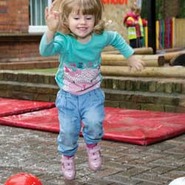 This is related to the transfer of skills. By using only apparatus that may be found at home, or that can be easily and cheaply sourced, the learning potential of practical PD sessions is enhanced. The apparatus used is often called 'neutral' or 'vanilla', which means that there is no specific agenda attached (as there is to a football or skipping rope). This may include socks, tights, plastic cups and plates, egg boxes, masking tape rolls, wrapping paper, paper bags, yoghurt pots, tea cloths and plastic bottle tops.
This is related to the transfer of skills. By using only apparatus that may be found at home, or that can be easily and cheaply sourced, the learning potential of practical PD sessions is enhanced. The apparatus used is often called 'neutral' or 'vanilla', which means that there is no specific agenda attached (as there is to a football or skipping rope). This may include socks, tights, plastic cups and plates, egg boxes, masking tape rolls, wrapping paper, paper bags, yoghurt pots, tea cloths and plastic bottle tops.
Relevance
- Avoids the financial outlay usually associated with physical activity initiatives.
- Encourages children to rehearse and refine skills in the home environment and also encourages participation by family members and peer groups.
- Encourages appreciation of the properties of the apparatus (such as size, weight, shape, feel, smell, length and sound), leading to more imaginative play and the use of language.
8. A 'canopy' learning experience is promoted
Children should be offered a range of physical experiences over the course of a day (the Government's 2011 activity guidelines recommend 180 minutes). These will probably fall into one of three categories, but all should be afforded to children in the settings that they experience. They will have their preferences, but aim for a wide variety and observe closely how they react to the opportunities offered.
Free physical play
Children will decide and act on their own ideas and initiatives, choosing any resources they need. Be aware that the most physically able children may 'take over' the space leaving the less able attempting to join in or imitate them. Free play often takes place outside and will usually include running, hiding, climbing, jumping and sometimes chasing.
Structured physical play
Adults choose the space and equipment to be used, and often initiate and join in activities. This may take place both inside and outside, so is more flexible and useful for practitioners as a means to observe children's behaviours and competencies.
Structured PD sessions
These will have specific objectives and overall aims linked to the eight principles. Structured sessions may be used as a form of assessment to highlight concerns or specific skills, or focus on issues of inclusion.
Structured sessions will have three components. Not all will be experienced in every sessions, but over the course of a week children should engage in a wide variety of physical activity:
- Movement experience linked to principles 1-5 - with an emphasis on locomotor skills, use of the environment and group work.
- Hand apparatus linked to principles 6 and 7.
- Large apparatus, including that only found at home, such as large cushions, mattresses, chairs and tables. Safety is paramount, so design short obstacle courses that children may construct themselves.
Relevance
- Children experience a wide variety of activities on a daily basis.
- All children may be included and engage to the best of their ability.
- Children may be observed in a range of situations - they may behave quite differently during organised or free play sessions.
- Adults may adapt and react to the changing needs and abilities of children.
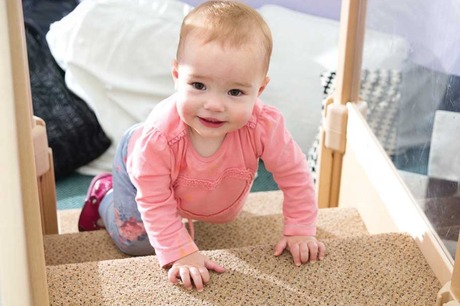
IMPLICATIONS FOR PRACTICE
The principles approach:
- offers practitioners the possibility of engaging children in a wide variety of PD opportunities and promoting confidence (in both adults and children) to react and adapt to different demands (both internal and external)
- assists a deeper understanding of why PD may promote learning and how this knowledge will be used to plan effective practical sessions
- offers flexibility in planning and delivery and so accommodates and encourages personal strengths and skills, ensuring that PD remains current and relevant to overall provision
- promotes an openness to other ideas, approaches and resources and a willingness to learn from different disciplines and initiatives worldwide
- values and uses children's own ideas, with their contributions recognised and supported by overall practice in their settings.
CONCLUSION
The eight guiding principles of early years PD have been developed over time and used to support practice in a wide variety of settings - therapeutic, sporting, health, care and education. They provide a foundation on which best practice may be built while accommodating the varying demands of professional lives.
- Keep an open mind - be interested in everything.
- Observe children moving in all situations - watch ballet, gymnastics and swimming sessions.
- Spend time in the local park.
- Read widely and attend as many different training days as possible.
- Be 'magpie like' about resources and make contacts with others who are interested.
Above all, relax and enjoy working with children in a physical capacity. It may be unexpectedly joyful.
Dr Lala Manners is director of Active Matters, www.activematters.org
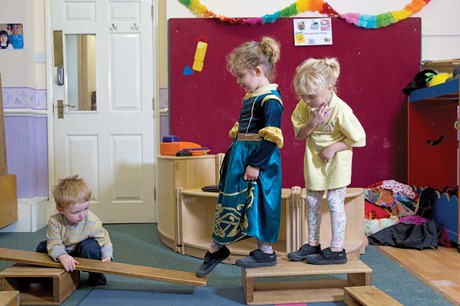
MORE INFORMATION
- A Moving Child Is A Learning Child by Gill Connell and Cheryl McCarthy, Free Spirit Publishing
- Active Matters, www.activematters.org
- Health and Wellbeing by Anne O'Connor, Practical Pre-School Books
- Early Movers: helping under 5s live active and healthy lives, British Heart Foundation, www.bhf.org.uk/publications/view-publication.aspx?ps=1002163
- Experiences in Movement and Music - Birth to Age Eight (5th ed) by Rae Pica, Cengage Learning, www.cengagebrain.co.nz/content/9781285207117.pdf
- Playing and Learning Outdoors (2nd ed) by Jan White, Routledge
- The Power of Physical Play (DVD), Siren Films, http://sirenfilms.co.uk/product/the-power-of-physical-play
- The Well Balanced Child: movement and early learning by Sally Goddard Blythe, Hawthorn Press
- UK physical activity guidelines, early years (under 5s) and early years (under 5s capable of walking), www.gov.uk/government/publications/uk-physical-activity-guidelines.









